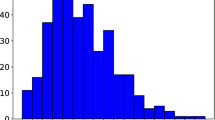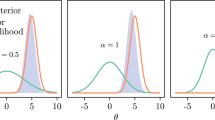Abstract
In this article we consider the sample size determination problem in the context of robust Bayesian parameter estimation of the Bernoulli model. Following a robust approach, we consider classes of conjugate Beta prior distributions for the unknown parameter. We assume that inference is robust if posterior quantities of interest (such as point estimates and limits of credible intervals) do not change too much as the prior varies in the selected classes of priors. For the sample size problem, we consider criteria based on predictive distributions of lower bound, upper bound and range of the posterior quantity of interest. The sample size is selected so that, before observing the data, one is confident to observe a small value for the posterior range and, depending on design goals, a large (small) value of the lower (upper) bound of the quantity of interest. We also discuss relationships with and comparison to non robust and non informative Bayesian methods.







Similar content being viewed by others
References
Adcock CJ (1997) Sample size determination: a review. Statistician 46:261–283
Berger JO (1984) The robust Bayesian viewpoint (with discussion). In: Kadane J (ed) Robustness of Bayesian analysis. North-Holland, Amsterdam
Berger JO (1990) Robust Bayesian analysis: sensitivity to the prior. J Stat Plan Inference 25(3):303–328
Brutti P, De Santis F (2008) Avoiding the range of equivalence in clinical trials: Robust Bayesian sample size determination for credible intervals. J Stat Plan Inference 138:1577–1591
Brutti P, De Santis F, Gubbiotti S (2008) Robust Bayesian sample size determination in clinical trials. Stat Med 27(13):2290–2306
Brutti P, De Santis F, Gubbiotti S (2009) Mixtures of prior distributions for predictive Bayesian sample size calculations in clinical trials. Stat Med 28(17):2185–2201
Brutti P, Gubbiotti S, Sambucini V (2011) An extension of the single threshold design for monitoring efficacy and safety in phase II clinical trials. Stat Med 30(14):1648–1664
Chaloner K, Verdinelli I (1995) Bayesian experimental design: a review. Stat Sci 10:237–308
DasGupta A, Mukhopadhyay S (1994) Uniform and subuniform posterior robustness: the sample size problem. J Stat Plan Inference 40:189–200
De Santis F (2006) Sample size determination for robust Bayesian analysis. J Am Stat Assoc 101(473):278–291
De Santis F (2007) Using historical data for Bayesian sample size determination. J R Stat Soc Ser A 170(1):95–113
Etzioni R, Kadane JB (1993) Optimal experimental design for another’s analysis. J Am Stat Assoc 88(424):1404–1411
Gubbiotti S, De Santis F (2011) A Bayesian method for the choice of the sample size in equivalence trials. Aust N Z J Stat 53(4):443–460
Ibrahim JG, Chen M (2000) Power prior distributions for regression models. Stat Sci 15(1):46–60
Joseph L, Belisle P (1997) Bayesian sample size determination for normal means and difference between normal means. Statistician 46(2):209–226
Kerman J (2011) Neutral noninformative and informative conjugate beta and gamma prior distributions. Electron J Stat 5:1450–1470
Neuenschwander B, Branson M, Spiegelhalter D (2009) A note on the power prior. Stat Med 28: 3562–3566
Sambucini V (2008) A Bayesian predictive two-stage design for phase ii clinical trials. Stat Med 27: 1199–1224
Simon R (1989) Optimal two-stage designs for phase II clinical trials. Control Clin Trials 10:1–10
Sivaganesan S, Berger JO (1989) Ranges of posterior measures for priors with unimodal contaminations. Ann Stat 17(2):868–889
Spiegelhalter DJ, Abrams K, Myles JP (2004) Bayesian approaches to clinical trials and health-care evaluation. Wiley, New York
Tsutakawa RK (1972) Design of experiment for bioassay. J Am Stat Assoc 67(339):585–590
Wang F, Gelfand AE (2002) A simulation-based approach to Bayesian sample size determination for performance under a given model and for separating models. Stat Sci 17(2):193–208
Acknowledgments
The authors would like to thank the editor and two anonymous reviewers for their interesting comments and helpful suggestions.
Author information
Authors and Affiliations
Corresponding author
Rights and permissions
About this article
Cite this article
De Santis, F., Fasciolo, M.C. & Gubbiotti, S. Predictive control of posterior robustness for sample size choice in a Bernoulli model. Stat Methods Appl 22, 319–340 (2013). https://doi.org/10.1007/s10260-012-0225-0
Accepted:
Published:
Issue Date:
DOI: https://doi.org/10.1007/s10260-012-0225-0




